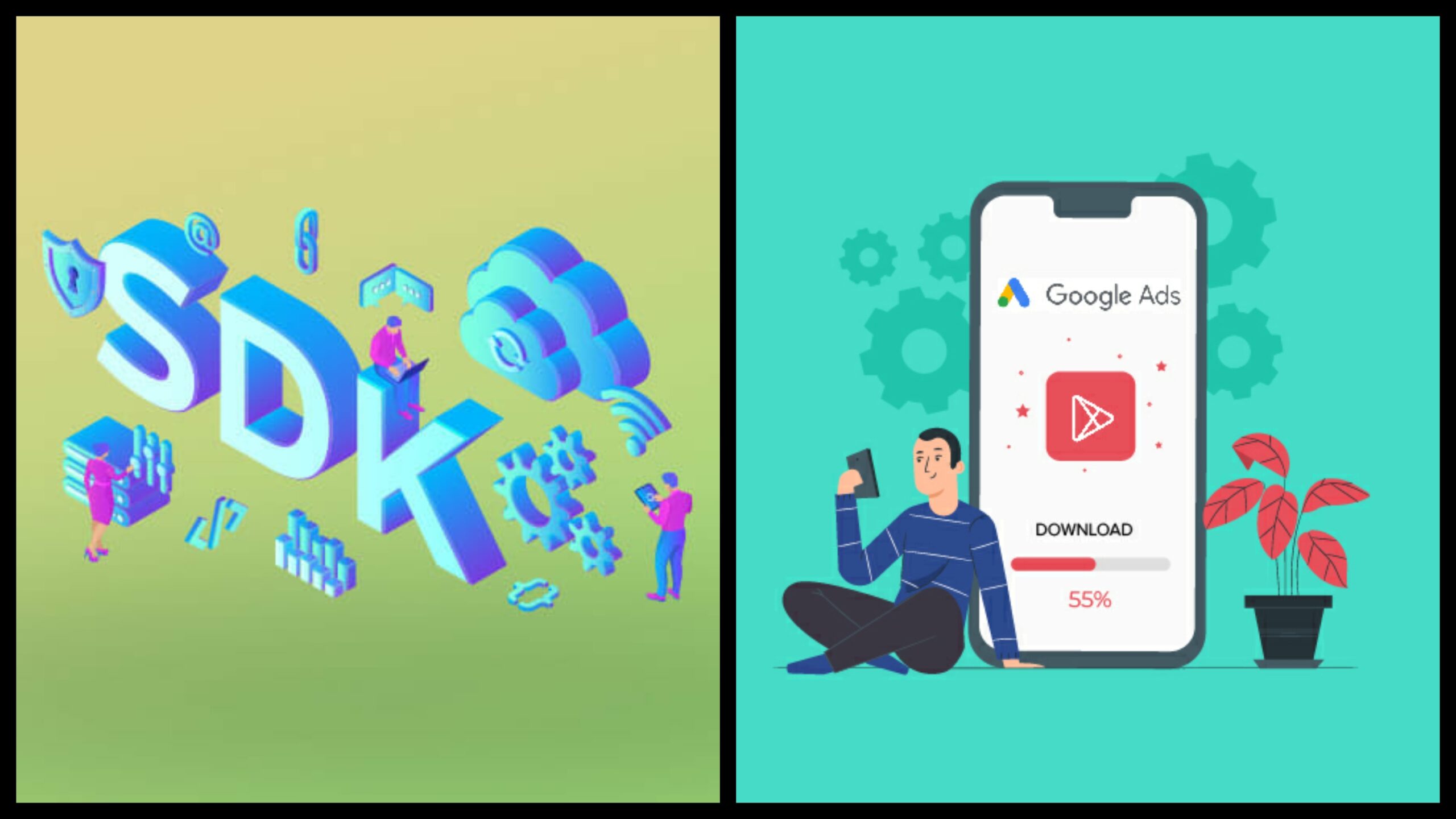
Advertising and monetization via the SDK
If you want to consistently make money from a mobile game or application, you need mobile advertising SDKs and other tools for monetization. Several software development kits (SDKs), a variety of ad unit types, and pricing models are available to app developers, allowing them to tailor their app monetization strategy and select the best revenue source for their requirements.
How does SDK advertising work?
The term “Software Development Kit” stands for SDK. SDK advertising refers to mobile SDKs designed to connect an application to a set of third-party advertising technologies and services in the context of mobile applications.
SDK advertising enables mobile developers to utilize a unique selection of tools, such as libraries, codebases, technical guides, and so on—despite its overall purpose being similar to that of advertising APIs and in-house systems. and use the ad networks created by the SDK developer. With these tools, developers can display and set up the best in-app ads for their apps.
SDK Promotions.
Advertising with an SDK has many benefits for publishers and developers alike. An SDK includes a set of tools and configuration options for optimally planning, positioning, and putting in place in-app advertisements, in addition to selecting the best and most relevant or impactful ad units.
An SDK, for instance, can be used by a mobile game developer to precisely configure placement (such as displaying interstitials between game sessions, such as after receiving a “game over”) and frequency (such as only displaying an ad every two “game over” screens to strike a balance between engagement and monetization).

How does SDK Monetization work?
Utilizing an SDK to monetize an application enables developers to implement new revenue streams without compromising the application’s user experience (UX).
Great SDKs likewise permit engineers to enhance their adaptation choices further in light of the fact that they give admittance to the most noteworthy appraised promotion organizations and advertisement creatives. App developers and publishers have the technology to boost revenue and profit by leveraging cutting-edge ad units from cutting-edge advertisers through programs like programmatic mediation and advanced ad unit types like interactive ads.
SDK Ad Units
Advertising SDKs provide a variety of ad unit options for planning and putting ads into an application. Instances of promotion units incorporate standard advertisements, interstitials, compensated recordings, playable (intelligent) promotions, local promotions, offer wall promotions, rich media advertisements, swipe advertisements, and some more.
How is SDK Ad Monetization Operational?
Even though the rules and procedures of each SDK platform are different, most of them require developers to follow the same steps:
Get an access key by signing up for the SDK platform.
Include specific code in the application to connect to the servers of the SDK developer.
Integrate the SDK into the application’s build by downloading it. Implement additional OS-specific functionality if necessary (for instance, installing additional code to request access to the device’s location data to use geo-targeting on Android).
In order to incorporate the SDK into your application, follow the development guidelines.
Use the control panel or the configuration page to add the application to the web platform of your SDK.
Start incorporating advertisements into the app.
To incorporate ad units into your application, all you need to do is follow this important procedure. Your SDK provider will collect advertising revenue for you automatically following implementation. Payout conditions and parameters can be found in the provider’s rules and terms of service.
For instance, you might not be able to pull out promotion income in the event that you haven’t arrived at least worth, for example, $100. Additionally, depending on the publisher’s country of origin, each provider has access to various payment options.
Cost of Ads: CPM versus CPA versus CPI.
Cost Per Mille (CPM), Cost Per Action (CPA), and Cost Per Install (CPI) are three of the ad pricing models that are used the most frequently for SDK monetization.
CPM: Per Mille Cost
Mille means one thousand in Latin. Cost Per Mille (CPM) charges advertisers for each one thousand times an advertisement is seen. The most common impression is the ad view, in which the number of times a user has been able to view an ad unit is proportional to the number of impressions recorded.
The essential benefit of the CPM valuing model is that clients don’t have to perform associations to produce impressions. The advertiser pays out after an impression is recorded for simply viewing the advertisement.
For instance, if an ad unit is worth $2.60 CPM and is viewed 3,000 times on your application, you will receive $7.80—the listed value for every 1,000 recorded views.
According to the promoter’s perspective, the Expense Per Mille equation is as per the following:
Value of the total ad spend divided by the number of thousands of impressions.
A likely weakness of a CPM crusade is moderately low normal returns, particularly on applications and properties that don’t create critical measures of perspectives.
However, it is the most widely used pricing model due to the fact that it requires the fewest user actions, making it an excellent option for passive ad revenue collection.
For instance, if an advertiser spends $200 on an ad unit that has been viewed 500,000 times (or 500 thousand times) by users, the CPM of that unit is $0.40.
An expected impediment of a CPM crusade is moderately low normal returns, particularly on applications and properties that don’t create huge measures of perspectives. However, it is the most widely used pricing model due to the fact that it requires the fewest user actions, making it an excellent option for passive ad revenue collection.
CPA: Cost Per Activity.
A pricing model known as Cost Per Action (CPA) pays publishers a fixed rate for a specific action that takes place within the application. Examples of such actions include new account registration, referral and partnership programs, the number of first-time app launches, and in-app events like purchases.
The CPA is calculated by dividing the total ad spend by the number of defined actions from the advertiser’s perspective.
For instance, if an advertiser spent $300 on a CPA ad campaign where the paid action was first-time application launches and 1,200 new users had launched the app for the first time, the CPA for that ad would be $300 divided by 1,200, or $0.25.
Buying premium currency in mobile games is a typical CPA-rewarded action. Publishers may receive a set amount of money proportional to the amount of premium currency the user purchased from a CPA-monetized app. When it comes to highly interactive mobile apps (games, etc.), CPA can be a very effective pricing model. However, it is also one of the more expensive options from the user’s perspective, which means that the number of paying users may not represent all of your users.
CPI: Price per Install
A particular type of CPA monetization known as Cost Per Install (CPI) explicitly rewards application installs. As a result, CPI and CPA calculation are identical: total amount spent on advertising divided by the number of actions (app installs in this instance).
Ad units like 30-second videos or interactive interstitials that end with an app store link, such as the Apple App Store or Google Play Store, work well with this method of monetization.
An advertiser receives a payment under the CPI monetization model for each user who downloads the application from the app store link.
Users typically do not have to open the app for the first time; In other words, even if the user never uses the app, a successful install will still result in a payout.
CPI may be more difficult to implement than a CPM model, despite being less demanding than the majority of CPA monetization models.
However, a CPI ad campaign can be run with a free-to-play application because the required interactions do not require the user to make a purchase.
Top 5 Monetization Models for Mobile Ads.
Banner ads, interstitial ads, rewarded videos, offer walls, and native ads are the five types of mobile ad units that have performed best.
1. ad banners
Mobile banner ads are rectangular units that can display creative content that is either static or animated. With a variety of sizes to choose from, they are one of the most widely used advertising units. Although the most widely used banner ad formats are adaptive, industry-standard formats include 32050, 320100, 300250 (IAB medium), 46860 (IAB full-size), and 72890 (IAB leaderboard).
In SDK advertising, adaptive banner ads come in two primary varieties:
-Banners with varying heights: banners with a variable height and a fixed width that is set by the publisher.
-Citizen banners: banners with a width that automatically matches the screen resolution and a fixed height (32, 50, or 90 pixels).
2. Ads that appear in the background.
Ad units that temporarily cover or replace the app’s interface in order to display an ad across the entirety of the screen are known as “interstitial ads.” These ads are displayed in full-screen mode.
Interstitials are typically interactive, allowing users to preview gameplay or features prior to installing the application. This kind of advertisement is often used to promote mobile games, encourage user engagement, and pique interest by giving users a preview of an app before they download it.
Similar to full-screen static and video advertisements, some interstitial advertisements are non-interactive. Even though they are less common, these ad units are less expensive to make and can be a cost-effective way to monetize.
3. Rewards for Ads
Ad units that are played in full screen are called “rewarded ads.” They have a number of important differences from non-interactive interstitial ads.
Rewarded ads, in contrast to standard interstitials, typically do not provide any form of interaction. They are instead typical video formats. Additionally, their duration is fixed, ranging from 20 to 60 seconds.
Last but not least, once you start seeing rewarded ads, you can’t stop them. The only way to exit a rewarded advertisement is to watch it completely because the user initiated it.
The user is rewarded with virtual currency or in-app items for watching the entire ad. As a result, mobile games almost always feature rewarded ads.
4. Offer Walls.
Offering a variety of rewards (offers) on a list (the “wall”) to the user in exchange for completing various monetized activities, offer wall ads—also spelled “offerwalls”—are a more complex form of rewarded ads.
An offer wall in a mobile game, for instance, might offer varying amounts of in-game currency in exchange for doing things like watching advertisements, installing an application, playing another mobile game and reaching a particular level or progress point, completing a survey, or going to an online shopping platform and making a purchase.
With offer walls, users can choose from a variety of offers and control their level of engagement with ads by combining multiple engagement and monetization methods.
5. Native adverts
Native advertising is when publishers of advertising content seamlessly integrate into the content of an application or website, making it appear as though they are an integral part of the application environment.
Native ads typically match the application’s styling, user interface (UI), text, and appearance in mobile applications. A native ad’s primary goal is to serve ad content without affecting the user experience and minimize disruption.
Top 10 App Monetization SDKs The following are the top 10 best-performing app monetization SDKs:
1. Facebook Audience Network
Through its Facebook-powered audience targeting tools, Facebook Audience Network enables publishers to benefit from Facebook’s extensive mobile market reach. With 27% of the app market and 47% of all app downloads, Facebook Audience Network is one of the best high-performance mobile ad network SDKs.
Using Facebook’s powerful targeting options and advertising algorithms, developers and publishers can target ads precisely by user age, location, gender, demographics, job sector, interests, and more with the FB Audience Network SDK. The interactive interstitials and rewarded ads served by the FB Audience Network SDK maximize engagement and ad revenue.
2. MoPub.
One of the few open-source mobile app advertising SDKs that performs well is MoPub. Developers and publishers can choose from direct ads, ad networks, and programmatic real-time bidding among MoPub’s tools for monetization. Halfbrick Studios, WordPress, and TuneIn are among the world-class MoPub users.
The MoPub SDK is well-known for its openness and transparency, robust analytics tools, and comprehensive support for numerous well-known ad formats. The MoPub SDK serves ads like videos, interactive ads, static content, HTML5, rich media ads, and more.
3. AdColony.
Over 1.5 billion people use AdColony, a premium ad network SDK and advertising platform. AdColony has one of the industry’s best fill rates, access to cutting-edge technologies, and some of the world’s most prestigious advertisers.
Promotions served utilizing the AdColony SDK can uphold top quality video creatives and innovations like moment play, conveying a top notch grade promotion serving experience. Publishers looking to monetize their properties with high-quality ad content will find the SDK to be a top choice due to its extensive audience targeting features and Aurora HD support.
4. AdMob from Google
Serving over 200 billion ad requests per month and partnering with over 1 million advertisers worldwide, Google AdMob is one of the best industry-leading ad SDKs. With an 88% app share, it is the mobile app monetization SDK that is used the most worldwide. Over 1.3 million mobile applications, including 286,000 games, include its features.
The SDK’s simplicity of use and its compatibility with Google technologies are the primary advantages of Google AdMob. Developers also do not have to worry about usage fees; Using AdMob is completely free. AdMob’s features include easy scaling, Google-powered analytics and insights tools, detailed monetization reports, and access to Google-approved advertisers of high quality.
5. Smaato.
For publishers and developers of mobile games, the Smaato SDK is a popular option. Smaato aggregates hundreds of advertising industry partners onto a single network, putting them in real-time competition for each impression.
The Smaato SDK’s user-friendly interface and feature-rich dashboard and control panel for integration options make it simple to integrate. Before the SDK is incorporated into the code of your app, adding a new application only requires a few clicks.
The Smaato Integration Center can also be used by publishers that use Smaato as their primary monetization platform to gain control over the mediation process and improve their earnings.
6. Unity adverts.
Unity Technologies, best known for developing the Unity video game engine, created the monetization SDK known as Unity Ads. Unity Ads’ availability is its primary benefit. If you developed your mobile app or game with the Unity engine, you can get Unity Ads for free from within the game development SDK Unity Editor.
Unity Ads can be used to monetize non-Unity apps by integrating the native SDK into your application project, despite the fact that it was initially developed for Unity engine applications.
Unity Ads is a powerful advertising and monetization SDK with a lot of features: CPM and CPI ad campaigns, numerous options for audience targeting, a user dashboard that is easy to use, and a built-in way to set up in-app purchases are all included.
7. AirPush.
AirPush is among the most seasoned and most settled US-put together promoting SDK designers with respect to the market, with north of 10 years of involvement adapting portable traffic.
Publishers and developers can maximize fill rates and effective CPM (eCPM) values while monetizing all types of mobile traffic with AirPush’s numerous unique features.
AirPush ensures that developers and publishers make the most money possible by utilizing internally developed, proprietary ad formats and the expertise of a skilled, global sales team. When compared to other monetization methods, which are more commonly used, the outcome is significantly higher profits. Coca-Cola, Amazon, and Toyota are among the world-class AirPush clients.
8. Fyber.
Fyber is a Berlin, Germany-based mobile advertising technology company and mobile SDK developer. Developers are able to take advantage of a substantial advertiser network and well-known monetization features thanks to their focus on a variety of high-effective mobile content advertising formats. North of 180 DSPs and great many sponsors join forces with Fyber, guaranteeing distributers approach excellent promotion content consistently.
On Fyber, rewarded video ads, offer walls, interstitials, and virtual currency management systems for mobile games are all served as ad units. Multiple proprietary technologies power Fyber ads, which are supported on iOS, Android, and Windows Phone devices to boost user engagement and retention.
9. Mintegral.
A cutting-edge, AI-driven programmatic advertising platform and an extensive network of advertisers in the Asia-Pacific (APAC) region are accessible to app publishers through the Mintegral SDK.
For monetizing games and applications in China, Japan, Korea, Australia, and the South-East Asia (SEA) region, Mintegral is the ideal full-stack solution. Mintegral obtained ISO 27001 certification in 2021, indicating that the SDK complies with international information security management standards. These certifications ensure the safety of advertisers’ and publishers’ brands by maintaining the highest possible quality of ads served by Mintegral.
10. Yandex.
The leading search engine and information services company in Russia and the CIS (Armenia, Azerbaijan, Belarus, Kazakhstan, Kyrgyzstan, Moldova, Tajikistan, and Uzbekistan) offers the app monetization solution known as the Yandex Mobile Ads SDK.
The Yandex Advertising Network and its thousands of advertiser partners are accessible to publishers and developers who incorporate the Yandex SDK into their iOS and Android applications. The Yandex SDK is an essential tool for reaching audiences in Russia and the CIS because YAN sites and applications have more than 65 million users.
Advertising and monetization advantages of the SDK.
In spite of the fact that coordinating a promoting SDK into a versatile application takes additional time and assets than easier, less code-weighty arrangements (e.g., APIs, advertisement labels), SDKs offer a total set-up of incorporated apparatuses and highlights, giving designers and distributers more prominent control.
For example, a SDK accompanies its own usefulness and documentation, making it simpler for non-engineers and staff with less specialized information to utilize. The built-in structures and functions of the SDK can be utilized by developers to speed up implementation, reduce development time, and accelerate content monetization.
Finally, SDKs are better suited for scaling up and down than APIs, allowing you to tailor your monetization strategies to your app’s precise audience, size, and reach. Most of the time, they come with built-in analytics and KPI tracking features that give publishers the accurate, real-time performance data and data points they need to improve revenue streams.
1. In mobile advertising, how are SDKs utilized?
Ads can be placed and configured within a mobile app by integrating the tools and functions of an SDK into the application. Because mobile applications have their own user interface (UI), they are unable to always render the same type of advertisements as web pages, so app-specific SDKs are used instead of standard advertising solutions geared toward web browsers.
2. Which SDKs do you think are the best?
Google AdMob, Facebook Audience Network, Smaato, MoPub, AirPush, and AdColony are some of the most commonly used SDKs. However, the type of mobile app or game you want to monetize is primarily what determines which SDK is best for you.
3. How can an SDK be used to make money?
Similar to the rest of the advertising industry, mobile advertising makes use of the supply and demand economics. Advertisers and demand-side platforms (DSPs) can display their ad inventory in a space provided by publishers and supply-side platforms (SSPs).
Using one of many different pricing models (CPM, CPA, CPI, CPC, etc.), a publisher charges advertisers to display ads on their space.
Every monetized user interaction with an advertisement—viewing, clicking, installing, etc.—receives a payment. In mobile advertising, the SDK’s job is to give publishers the tools they need to place ads, set them up, and choose a good pricing model.
You must use the appropriate SDK and pricing model for your app and audience because each application is unique.



Leave a Reply